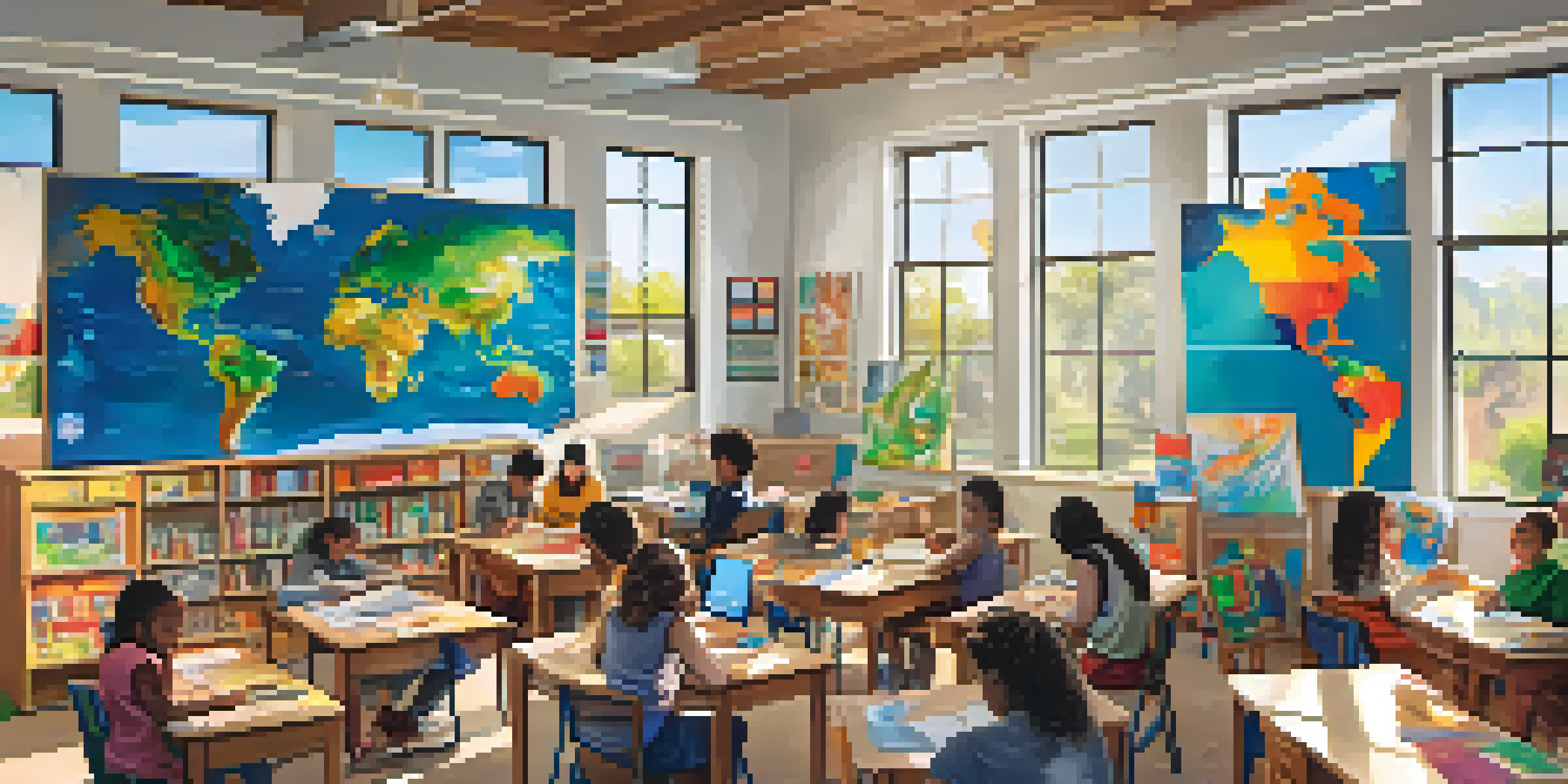Interdisciplinary Learning: Engaging Students in Real-World Issues

What is Interdisciplinary Learning and Why It Matters
Interdisciplinary learning is an educational approach that connects multiple subjects to solve complex problems. By blending disciplines such as science, math, and the arts, students gain a holistic understanding of issues they face in the real world. This method not only enhances critical thinking but also fosters collaboration among students, making learning more relevant and engaging.
Education is not the filling of a pail, but the lighting of a fire.
Imagine a project where students study climate change by examining scientific data, exploring its historical context, and expressing their findings through art. This type of learning encourages students to see the interconnectedness of various fields, preparing them for the multifaceted challenges they will encounter in life. It also promotes a sense of ownership over their education, as they can see the practical applications of their studies.
In today’s rapidly changing world, educators recognize the importance of teaching students to think beyond traditional subject boundaries. Interdisciplinary learning not only makes lessons more dynamic but also empowers students to become innovative problem solvers who are equipped to tackle global issues.
Real-World Issues That Inspire Interdisciplinary Learning
Engaging with real-world issues is a cornerstone of interdisciplinary learning. Topics like climate change, social justice, and public health not only spark students' interest but also make their education feel relevant. For example, a project on water scarcity might involve science experiments on filtration, mathematical calculations on water usage, and creative storytelling about communities affected by the issue.

Using real-world problems as a basis for learning helps students understand the significance of their education. When students can connect classroom activities to real-life scenarios, they are more likely to stay engaged and motivated. This alignment also helps them develop empathy, as they learn about the various perspectives surrounding these complex issues.
Interdisciplinary Learning Explained
This educational approach connects multiple subjects to help students tackle complex real-world problems.
Moreover, interdisciplinary approaches allow students to see the impact of their actions. By collaborating on solutions to real-world problems, they can appreciate their role as active citizens and the importance of working together, regardless of their individual interests or strengths.
Benefits of Interdisciplinary Learning for Students
One of the standout benefits of interdisciplinary learning is its ability to cultivate critical thinking skills. When students are exposed to multifaceted problems, they learn to analyze information from different angles and make informed decisions. This skill set is incredibly valuable not only in academic settings but also in everyday life and future careers.
The greatest danger in times of turbulence is not the turbulence; it is to act with yesterday's logic.
Additionally, interdisciplinary learning enhances creativity. By encouraging students to draw from various disciplines, they can come up with unique solutions that they might not have considered within the confines of a single subject. This kind of innovative thinking is essential in today’s job market, where adaptability and creativity are highly sought after.
Finally, this learning approach promotes teamwork. Students engage in collaborative projects, learning how to communicate effectively and leverage each other's strengths. These social skills are crucial for success in any field, making students well-rounded individuals ready to tackle future challenges.
Challenges of Implementing Interdisciplinary Learning
While interdisciplinary learning offers numerous benefits, it does come with its own set of challenges. One significant hurdle is the need for educators to work collaboratively across different subjects. This requires time, communication, and a shared vision, which can be difficult to coordinate in many educational settings.
Another challenge is the assessment of student learning in interdisciplinary projects. Traditional grading systems may not effectively capture students' understanding or contributions when working on multifaceted issues. Educators may need to develop new assessment methods that consider the diverse skills and knowledge students bring to these projects.
Real-World Issues Engage Students
By addressing topics like climate change and social justice, students find their education more relevant and motivating.
Finally, there can be resistance to change from both educators and institutions. Some may be hesitant to move away from traditional teaching methods, fearing that interdisciplinary approaches may dilute subject-specific knowledge. Overcoming this resistance requires strong leadership and ongoing professional development to show the value of this innovative approach.
Successful Examples of Interdisciplinary Learning
There are numerous success stories that highlight the effectiveness of interdisciplinary learning. For instance, a school in San Diego combined science and art to address local pollution issues. Students created informative murals that raised awareness and sparked community discussions, showcasing their understanding of both the science behind pollution and the power of art as a communication tool.
Another example comes from a project in a New York high school where students tackled food insecurity. They engaged in research across subjects such as economics, health, and environmental science to develop a community garden. This initiative not only provided fresh produce but also taught students about sustainability and the importance of local resources.
These examples illustrate how interdisciplinary learning can lead to tangible outcomes that benefit communities while enriching students' educational experiences. Such projects can serve as models for other schools looking to implement similar approaches, demonstrating that real-world engagement leads to meaningful learning.
How Educators Can Foster Interdisciplinary Learning
Educators play a crucial role in fostering interdisciplinary learning within their classrooms. One effective strategy is to design project-based learning experiences that require students to draw on knowledge from various subjects. By framing tasks around real-world challenges, teachers can inspire students to collaborate and think critically across disciplines.
Encouraging open dialogue among educators is another essential step. By sharing ideas and resources, teachers can create integrated lesson plans that enrich the curriculum. Professional development workshops focused on interdisciplinary strategies can also equip educators with the tools they need to navigate this approach successfully.
Benefits for Future Success
Interdisciplinary learning cultivates critical thinking, creativity, and teamwork, preparing students for diverse challenges.
Lastly, educators should create a classroom environment that promotes curiosity and exploration. Encouraging students to ask questions, pursue their interests, and collaborate with peers can lead to richer, more engaging learning experiences. This supportive atmosphere is vital for nurturing the innovative thinking that interdisciplinary learning aims to develop.
The Future of Interdisciplinary Learning in Education
As the landscape of education continues to evolve, the importance of interdisciplinary learning is likely to grow. With the increasing complexity of global challenges, preparing students to think critically and work collaboratively is essential. Educators and policymakers are beginning to recognize that traditional teaching methods may not adequately equip students for the future.
Emerging technologies also present new opportunities for interdisciplinary learning. Online resources, virtual reality simulations, and interactive platforms can facilitate collaborative projects that transcend subject boundaries. These tools can engage students in ways that were previously unimaginable, making learning more dynamic and accessible.

Ultimately, the future of education may hinge on our ability to integrate disciplines and address real-world issues. By embracing interdisciplinary learning, we can empower the next generation of thinkers, creators, and problem solvers who are ready to make a positive impact on the world.